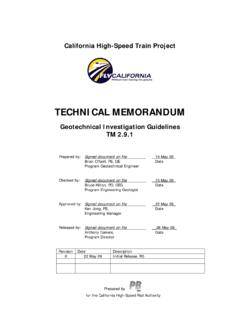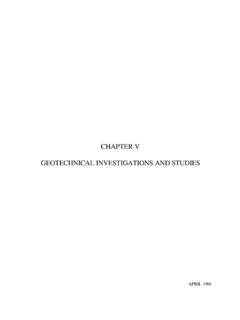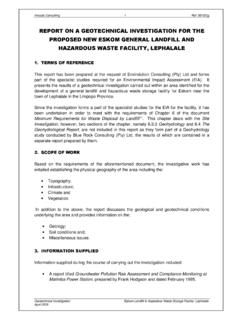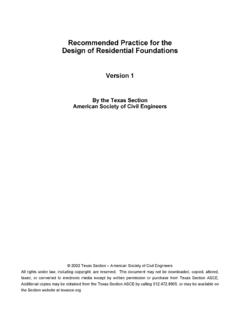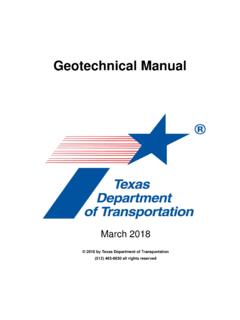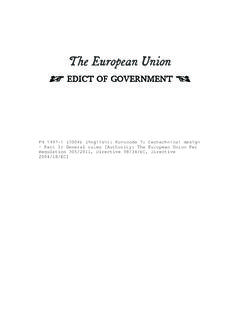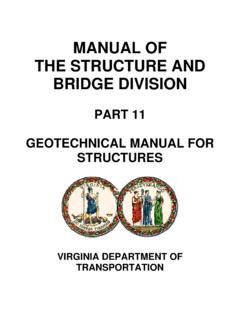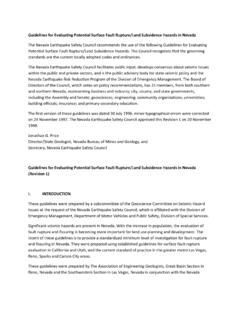Transcription of GEOTECHNICAL INVESTIGATION AND ANALYSIS …
1 GEOTECHNICAL INVESTIGATION AND ANALYSIS REQUIREMENTS FOR STRUCTURES March 2004 Updated December 1, 2017 MICHIGAN DEPARTMENT OF TRANSPORTATION BUREAU OF BRIDGES AND STRUCTURES GEOTECHNICAL SERVICES SECTION Engineering Manual Preamble This manual provides guidance to administrative, engineering, and technical staff. Engineering practice requires that professionals use a combination of technical skills and judgment in decision making. Engineering judgment is necessary to allow decisions to account for unique site-specific conditions and considerations to provide high quality products, within budget, and to protect the public health, safety, and welfare. This manual provides the general operational guidelines; however, it is understood that adaptation, adjustments, and deviations are sometimes necessary.
2 Innovation is a key foundational element to advance the state of engineering practice and develop more effective and efficient engineering solutions and materials. As such, it is essential that our engineering manuals provide a vehicle to promote, pilot, or implement technologies or practices that provide efficiencies and quality products, while maintaining the safety, health, and welfare of the public. It is expected when making significant or impactful deviations from the technical information from these guidance materials, that reasonable consultations with experts, technical committees, and/or policy setting bodies occur prior to actions within the timeframes allowed. It is also expected that these consultations will eliminate any potential conflicts of interest, perceived or otherwise. MDOT Leadership is committed to a culture of innovation to optimize engineering solutions.
3 The National Society of Professional Engineers Code of Ethics for Engineering is founded on six fundamental canons. Those canons are provided below. Engineers, in the fulfillment of their professional duties, shall: 1. Hold paramount the safety, health, and welfare of the public. 2. Perform Services only in areas of their competence. 3. Issue public statement only in an objective and truthful manner. 4. Act for each employer or client as faithful agents or trustees. 5. Avoid deceptive acts. 6. Conduct themselves honorably, reasonably, ethically and lawfully so as to enhance the honor, reputation, and usefulness of the profession. A. DESCRIPTION 1. The work performed by the consultant GEOTECHNICAL engineer under these requirements shall consist of making a complete foundation INVESTIGATION for the adequate design and construction of bridges and other associated structures.
4 A complete foundation INVESTIGATION and ANALYSIS shall consist of an adequate program of field sampling, laboratory testing, and engineering ANALYSIS and evaluation, with the results presented in report form. The INVESTIGATION and ANALYSIS shall be performed in compliance with the procedures outlined in this document and generally accepted principles of sound engineering practice. The INVESTIGATION and ANALYSIS shall be under the general supervision and subject to the approval of the M DOT foundation ANALYSIS engineer. Unless otherwise subsequently noted, later references to as approved or directed will imply as approved or directed by the M DOT foundation ANALYSIS engineer. B. PERFORMANCE OF FIELD WORK ON PRIVATE PROPERTY 1.
5 Entry Permission It is the responsibility of the consultant GEOTECHNICAL engineer to obtain permission for entry from each property owner whose property must be entered for any reason. 2. Damages It is also the responsibility of the consultant GEOTECHNICAL engineer acting as a representative of the Michigan Department of Transportation or local public agency to compensate the property owners for any damage incurred to their property because of the GEOTECHNICAL INVESTIGATION . 3. Railroad Expenses This item consists of the actual cost invoiced by the railroad for railroad permits, flagman, right of entry, etc. The consultant GEOTECHNICAL engineer shall obtain the written approval of the State before incurring any railroad expense.
6 C. EQUIPMENT 1. The equipment used shall be hand operated or power drilling, and/or driving equipment, or other tools or equipment considered suitable or necessary for determination of the limits and conditions of the various soil strata, and for obtaining samples for examination, field classification, and laboratory ANALYSIS . D. LOCATION AND DEPTH OF BORINGS 1. General This section is to be used as a guide in planning the boring program. It is not the intent that the location, boring interval, and depth specified herein be rigidly adhered to. The consultant shall make use of available soils and geologic maps, water well records, reports, publications, aerial photographs, and other reference material which are available to prepare a preliminary boring program.
7 Borings shall then be selectively located during a field check attended by the consultant GEOTECHNICAL engineer and by the M DOT foundation ANALYSIS engineer or his appointed representative. The actual location, spacing, and depth of borings shall be dictated by the topography, geologic conditions, visible soil conditions, and design considerations, and in accordance with the practices set forth herein. 2. Depth of Exploration Borings should extend through any unsuitable or questionable foundation materials and sufficiently deep into stable soils that the potential for settlement from compression of that layer or that the deeper underlying soils is determined. If deep excavations are required for building the structure, the explorations should be carried to at least times the depth of the excavation in order to locate and determine groundwater levels in any aquifers that may exist below the level of excavation.
8 This is necessary to design a dewatering system that may be required in such deep excavations and to avoid heave or disturbance to the bottom of the excavations. 3. Spacing and Number of Borings Often borings are made in several stages. In the first stage, relatively few borings are made. Based upon these findings, additional borings may be made between the initial borings to define soil conditions in greater detail. The selection of sample type and frequency is determined by soil conditions and requirements of the structure. Where soil conditions are favorable, especially for small structures, all borings are often completed in the first phase of the INVESTIGATION . If soil conditions are well known with fairly thick individual layers of consistent physical properties, relatively widely spaced borings may be sufficient.
9 If, however, soil conditions vary appreciably from place to place, more closely spaced borings will be required. The number and spacing must be determined by engineering judgment as the work progresses. There should be a sufficient number to determine the stratification and interrelation of the soils to the extent economically feasible. The exploration should be conducted considering the requirements of the structure. All soil data necessary for the selection of the foundation and its design must be obtained. 4. Guidelines for Subsurface Investigations With the above general concepts in mind, the following guidelines for location and depth of borings are to be followed. The boring frequency for most structures is one boring per substructure unit (such as a bridge pier) under 100 feet long and two borings for footings longer than 100 feet.
10 For retaining walls and sewers, one boring every 300 feet, and for deep cuts and high fills, one boring every 200 to 500 feet depending on soil conditions. The sampling frequency for sands and gravels is every 5 feet in depth where a standard penetration (resistance to driving) test (SPT) is obtained. If spread footings are proposed, the borings are extended until sufficient information has been obtained to complete the settlement ANALYSIS . If piles are anticipated, the boring is stopped 10 feet below the estimated bottom of the piling. The sampling frequency for cohesive (clay-like) materials is every 5 feet in depth to a depth of two times the footing width or 30 feet, whichever is greater, below the bottom of the proposed footing elevation.










